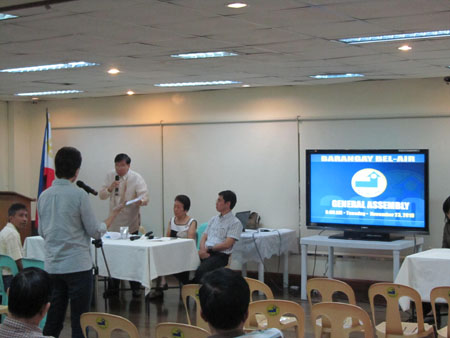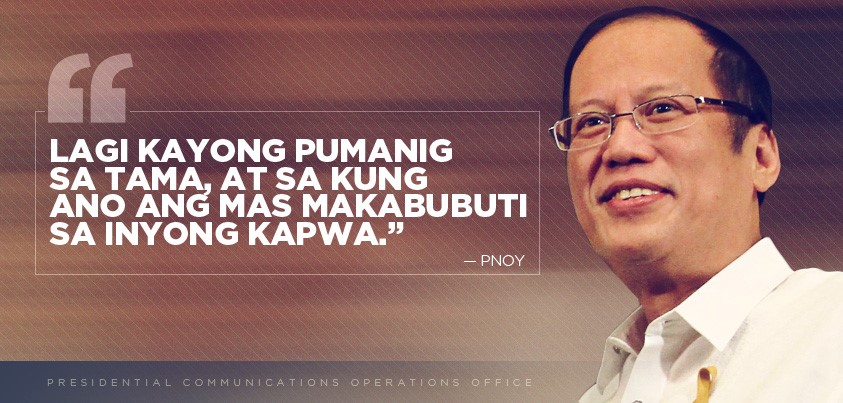The first Barangay Assembly empowered by an active citizenry
I am reposting this article written on Blog Watch/Philippine Online Chronicles, on December 6, 2010 to share awareness in the nationwide Barangay Assembly on March 29, 2014. There are more details at the the Facebook event Power to the People – #BrgyAssembly and the DILG memo
How much do you really know about your barangay?
- Do you know that a barangay is a virtual “republic”: distinct territory, people, resources, government, police power, power to tax? That the total number of barangays throughout the country currently numbering 42,025 makes up the foundation of the national government.
- Do you know that its highest authority is the Barangay Assembly, a legislative governing body or parliament, consisting of all the constituents?
- Do you know that a barangay earns more in revenues than average corporations, its officials earning allowances equal to that of a company executive? That it never goes bankrupt because it has a guaranteed share of national taxes (IRA)?
Most of all, instead of the self-reliant community it was envisioned to be, the barangay has become the political tool of trapos who manipulate or corrupt its voters. That unless responsible citizens get involved in it, corruption and poverty will persist in Philippine society.
Empowered citizenry starts in the barangay
 Aurora Pijuan, the Gising Barangay Movement (GBM) Convenor of Barangay Bel-air , Makati City believes that people need to show in real terms how and when to assert their sovereign power and demand good governance right in their own backyard. Ms. Pijuan called for a Sangguniang Barangay session and convening a barangay national assembly at the same time on November 23, 2010. She figures that, “throughout the country, barangays meet at the urging or direction of the Department of Interior and Local Governments (DILG), not at the discretion of officials nor the constituents. This means autonomy or self-governance has not yet taken root in the consciousness of the citizenry.”
Aurora Pijuan, the Gising Barangay Movement (GBM) Convenor of Barangay Bel-air , Makati City believes that people need to show in real terms how and when to assert their sovereign power and demand good governance right in their own backyard. Ms. Pijuan called for a Sangguniang Barangay session and convening a barangay national assembly at the same time on November 23, 2010. She figures that, “throughout the country, barangays meet at the urging or direction of the Department of Interior and Local Governments (DILG), not at the discretion of officials nor the constituents. This means autonomy or self-governance has not yet taken root in the consciousness of the citizenry.”
In taking this initiative, she wanted it known that Barangay Bel Air is one barangay where sovereign citizens are awake to their duty and role in inducing good governance for their community. She added that “unless we do act, others will not understand what is meant by a good government OF the people, BY the people, and FOR the people. It is time people adopt an ASSERTIVE BRAND of sovereignty and be free from manipulation by presumptuous officials. Otherwise, our political maturity will remain stunted and we remain a nation of zombies.”
Being active in the Barangay assembly is just one of the ways for empowerment. The law requires this assembly to meet at least twice a year in order “to hear and pass upon the activities and finances of the barangay” (Section 398, R.A. 7160, the Local Government Code). This means it should convene as often as necessary, not just twice as is the current practice. Some don’t convene at all or if they do, its proceedings are conducted improperly. Does your barangay meet?
First barangay assembly active as an empowered citizenry
Au Pijuan invoked Section 397b of RA 7160 or the Local Government Code of the Philippines and presented a resolution at the scheduled barangay assembly on the scheduled date, as follows.
Whereas, the Barangay Assembly of Barangay Bel Air — hereafter referred to as “this Assembly” — was officially convened by virtue of a formal written notice issued to the residents of Barangay Bel Air dated November 15 2010.
Whereas, this Assembly represents the collective interests or the common good of the citizens of Barangay Bel Air;
Whereas, this Assembly possesses the right to directly propose, enact, or amend any ordinance as provided under Sec. 397b of R.A. 7160, The Local Government Code;
Whereas, it is the desire of the members of this Assembly, individually and collectively, to institutionalize and uphold a regime of autonomy or self governance characterized by transparency and public accountability in its governance;
Now therefore, be it resolved, as it is hereby resolved, as follows:
1. That this Assembly directs the Office of the Chairman and the Sangguniang Barangay to make productive use of the Internet in assuring transparency and timely recording of transactions, particularly its financial operations;
2. That with respect to budget management, all income generated and expenditures shall be uploaded to the Internet within twenty four hours of receipt or disbursement in order to keep all members of this Assembly informed and up-dated on the financial condition of the Barangay;
3. That in order to promote interest in civic or community affairs and maintain a high level of involvement among Bel Air citizens, this Assembly shall convene bimonthly, or every two months, so as to afford its members ample opportunity to deliberate on issues of common interest and have the same resolved by consensus or general agreement;
4. Resolved, finally, that the proceedings of this Assembly shall observe Parliamentary Rules of Order and formality befitting its role as the supreme governing body of the community of Barangay Bel Air.
ADOPTED THIS 23RD DAY OF NOVEMBER, YEAR TWO THOUSAND AND TEN
 She was ready for objections from any of the barangay officials. She read a legal opinion from the DILG that there was no “legal impediment to your plan of calling a Sangguniang Barangay Session and convening a barangay assembly.” The resolution was soon carried but later on questioned by another official that it should not be passed for “delicadeza” sake. The official felt that this resolution should be taken up by the new barangay officers and not them, the outgoing officials. The feisty Au Pijuan kept challenging him to give a legal position. Since there was no legal impediment, the resolution was passed. It was the first time a resolution was initiated by a private citizen during a barangay assembly and concurrently passed – a historic first not only in Barangay Bel-air but the whole Philippines as well.
She was ready for objections from any of the barangay officials. She read a legal opinion from the DILG that there was no “legal impediment to your plan of calling a Sangguniang Barangay Session and convening a barangay assembly.” The resolution was soon carried but later on questioned by another official that it should not be passed for “delicadeza” sake. The official felt that this resolution should be taken up by the new barangay officers and not them, the outgoing officials. The feisty Au Pijuan kept challenging him to give a legal position. Since there was no legal impediment, the resolution was passed. It was the first time a resolution was initiated by a private citizen during a barangay assembly and concurrently passed – a historic first not only in Barangay Bel-air but the whole Philippines as well.
Ms. Pijuan hopes that the rest of the citizenry take action in their own barangays and call for regular meetings of their barangay assembly. Invoking Section 397b of RA 7160 is a start, just what Ms. Pijuan did. The law is clear that “Its meetings shall be held upon call of the punong barangay or of at least four (4) members of the sangguniang barangay, or upon written petition of at least five percent (5%) of the assembly members.”
Barangays, our “small republics”
Actual residents of the barangay are assembly members who are part of the barangay assembly. Only this Assembly can hold accountable the chairman, the sanggunian, and their appointees for their performance. Manuel E. Valdehuesa Jr, author of “Guide to Empowering the Filipino People” adds that “it is only through this Assembly that every Filipino, apart from his vote, can speak out as a sovereign citizen. Without it, no consensus can arise on public issues or crystallize the popular will. Opinion polls do not produce consensus, nor do they express solidarity. Only formal deliberations and exchange can produce consensus and agreement.”
The Big Philippine Republic draws its life source and political will from the barangay, these small republics. To neglect even one barangay is to weaken the chain of over 42,000 small republics that make up this Big Republic, Indeed, dutiful citizens are the strength of a republic.
Reference material on the barangay from “Guide to Empowering the Filipino People”, by Gising Barangay Movememnt.
Photos by Noemi Lardizabal-Dado .Some Rights Reserved

